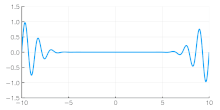Phase velocity
If the wave has higher frequency oscillations, the wavelength must be shortened for the phase velocity to remain constant.[2] Additionally, the phase velocity of electromagnetic radiation may – under certain circumstances (for example anomalous dispersion) – exceed the speed of light in vacuum, but this does not indicate any superluminal information or energy transfer.For this it is necessary to mathematically write the beat or signal as a low frequency envelope multiplying a carrier.This commonly appears in wireless communication when modulation (a change in amplitude and/or phase) is employed to send data.To gain some intuition for this definition, we consider a superposition of (cosine) waves f(x, t) with their respective angular frequencies and wavevectors.



Frequency dispersiongravity wavesgroup velocitywave packetpropagates in any mediumvelocityfrequencywavelengthtime periodangular frequencywavenumberwavevectorelectromagnetic radiationanomalous dispersionspeed of lightsuperluminalArnold SommerfeldLéon Brillouinmodulationrefractive indexdispersivedispersion relationCherenkov radiationDispersion (optics)Propagation delayShear wave splittingWave propagationWave propagation speedPlanck constantBibcodeBrillouin, LéonSignal